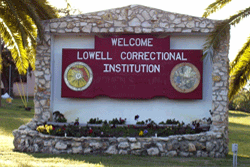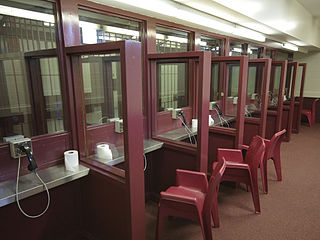
Incarceration in the United States is one of the primary means of punishment for crime in the United States. In 2023, over five million people were under supervision by the criminal justice system, with nearly two million people incarcerated in state or federal prisons and local jails. The United States has the largest known prison population in the world, it has 5% of the world’s population, and 20% of the world’s incarcerated persons. China, with four times more inhabitants, has fewer persons in prison. Prison populations grew dramatically beginning in the 1970s, but began a decline around 2009, dropping 25% by year-end 2021.

Recidivism is the act of a person repeating an undesirable behavior after they have experienced negative consequences of that behavior, or have been trained to extinguish it. Recidivism is also used to refer to the percentage of former prisoners who are rearrested for a similar offense.

Rehabilitation is the process of re-educating those who have committed a crime and preparing them to re-enter society. The goal is to address all of the underlying root causes of crime in order to decrease the rate of recidivism once inmates are released from prison. It generally involves psychological approaches which target the cognitive distortions associated with specific kinds of crime committed by individual offenders, but it may also entail more general education like reading skills and career training. The goal is to re-integrate offenders back into society.

The Ohio Reformatory for Women (ORW) is a state prison for women owned and operated by the Ohio Department of Rehabilitation and Correction in Marysville, Ohio. It opened in September 1916, when 34 female inmates were transferred from the Ohio Penitentiary in Columbus. ORW is a multi-security, state facility. As of July 2019, 2,394 female inmates were living at the prison ranging from minimum-security inmates all the way up to one inmate on death row. It was the fifth prison in the United States, in modern times, to open a nursery for imprisoned mothers and their babies located within the institution. The Achieving Baby Care Success (ABC) program was the first in the state to keep infants with their mothers.

The Texas Department of Criminal Justice (TDCJ) is a department of the government of the U.S. state of Texas. The TDCJ is responsible for statewide criminal justice for adult offenders, including managing offenders in state prisons, state jails, and private correctional facilities, funding and certain oversight of community supervision, and supervision of offenders released from prison on parole or mandatory supervision. The TDCJ operates the largest prison system in the United States.

Incapacitation in the context of criminal sentencing philosophy is one of the functions of punishment. It involves capital punishment, sending an offender to prison, or possibly restricting their freedom in the community, to protect society and prevent that person from committing further crimes. Incarceration, as the primary mechanism for incapacitation, is also used as to try to deter future offending.

A prison, also known as a jail, gaol, penitentiary, detention center, correction center, correctional facility, or remand center, is a facility where people are confined against their will and denied a variety of freedoms under the authority of the state, generally as punishment for various crimes. Authorities most commonly use prisons within a criminal-justice system: people charged with crimes may be imprisoned until their trial; those who have pled or been found guilty of crimes at trial may be sentenced to a specified period of imprisonment.

Lowell Correctional Institution is a women's prison in unincorporated Marion County, Florida, north of Ocala, in the unincorporated area of Lowell. A part of the Florida Department of Corrections, it serves as the primary prison for women in the state. Almost 3,000 women are incarcerated in the complex, which includes the Lowell Annex. As of 2015 2,696 women are in the main Lowell CI, making it the largest prison for women in the United States; its prison population became larger than that of the Central California Women's Facility that year.

As of 2013, across the world, 625,000 women and children were being incarcerated in correctional facilities, and the female prison population was increasing in all continents. The list of countries by incarceration rate includes a main table with a column for the historical and current percentage of prisoners who are female.
Sister Elaine Roulet was a Roman Catholic sister who created programs that connect incarcerated mothers and their children. She was instrumental in the prison reform movement and established the precedent of connecting imprisoned mothers with their babies that many United States prisons now use as a model.
Prison overcrowding in the United States is a social phenomenon occurring when the demand for space in a U.S. prison exceeds the capacity for prisoners. The issues associated with prison overcrowding are not new, and have been brewing for many years. During the United States' War on Drugs, the states were left responsible for solving the prison overcrowding issue with a limited amount of money. Moreover, federal prison populations may increase if states adhere to federal policies, such as mandatory minimum sentences. On the other hand, the Justice Department provides billions of dollars a year for state and local law enforcement to ensure they follow the policies set forth by the federal government concerning U.S. prisons. Prison overcrowding has affected some states more than others, but overall, the risks of overcrowding are substantial and there are solutions to this problem.

The incarceration of women in the United States refers to the imprisonment of women in both prisons and jails in the United States. There are approximately 219,000 incarcerated women in the US according to a November 2018 report by the Prison Policy Initiative, and the rate of incarceration of women in the United States is at a historic and global high, with 133 women in correctional facilities per every 100,000 female citizens. The United States is home to just 4% of the world's female population, yet the US is responsible for 33% of the entire world's incarcerated female population. The steep rise in the population of incarcerated women in the US is linked to the complex history of the war on drugs and the US's prison–industrial complex, which lead to mass incarceration among many demographics, but had particularly dramatic impacts on women and especially women of color. However, women made up only 10.4% of the US prison and jail population, as of 2015.

Relationships of incarcerated individuals are the familial and romantic relations of individuals in prisons or jails. Although the population of incarcerated men and women is considered quite high in many countries, there is relatively little research on the effects of incarceration on the inmates' social worlds. However, it has been demonstrated that inmate relationships play a seminal role in their well-being both during and after incarceration, making such research important in improving their overall health, and lowering rates of recidivism.
The use of shackles or restraints on pregnant women is a common practice in prisons and jails in the United States. Shackling is defined as "using any physical restraint or mechanical device to control the movement of a prisoner's body or limbs, including handcuffs, leg shackles, and belly chains". For females, shackles or handcuffs are placed around the ankles, wrists, or around the stomach. The shackling of pregnant women occurs while they are transported within a facility, transported to a hospital, and/or during and after childbirth. Restraints are also used on detained pregnant women in immigration detention facilities.
Gender-responsive prisons are prisons constructed to provide gender-specific care to incarcerated women. Contemporary sex-based prison programs were presented as a solution to the rapidly increasing number of women in the prison industrial complex and the overcrowding of California's prisons. These programs vary in intent and implementation and are based on the idea that female offenders differ from their male counterparts in their personal histories and pathways to crime. Multi-dimensional programs oriented toward female behaviors are considered by many to be effective in curbing recidivism.
People in prison are more likely than the general United States population to have received a mental disorder diagnosis, and women in prison have higher rates of mental illness and mental health treatment than do men in prison. Furthermore, women in prisons are three times more likely than the general population to report poor physical and mental health. Women are the fastest growing demographic of the United States prison population. As of 2019, there are about 222,500 women incarcerated in state and federal prisons in the United States. Women comprise roughly 8% of all inmates in the United States.
In the United States, prisons are obligated to provide health care to prisoners. Such health care is sometimes called correctional medicine. In women's prisons, correctional medicine includes attention to reproductive health.
Prisoner reentry is the process by which prisoners who have been released return to the community. Many types of programs have been implemented with the goal of reducing recidivism and have been found to be effective for this purpose. Consideration for the conditions of the communities formerly incarcerated individuals are re-entering, which are often disadvantaged, is a fundamental part of successful re-entry.
Decatur Correctional Center is a prison for women in Decatur, Illinois. It is operated by the Illinois Department of Corrections (IDOC). It first opened on January 24, 2000. Sex offenders are not placed in Decatur Correctional.







